2. 中海油研究总院, 北京 100027
2. CNOOC Research Institute, Beijing 100027, China
热模拟可再现油气盆地的热演化历史,在油气生气和储集过程中,盆地的热演化决定着烃类成熟度史.沉积盆地中岩浆侵入体是除断裂活动带、放射性元素富集区之外的最主要的局部热源[1],其对围岩的热影响一直以来在国内外受到广泛的重视[2-8].王有孝、朱传庆等[9-10]发现异常地热对烃源岩的有机质生烃过程和烃类成熟作用有明显影响.Othman等[11]发现侵入体的存在会使烃源岩的生油窗深度变浅.冯乔等[12]认为侵入体余热可以使生油层早熟,并使其附近围岩中的有机质丰度降低.万从礼等[13]认为基性岩浆带来大量的热量和地幔物质,并产生极高的压力,加速了周围烃源岩的成熟演化,且促使其排烃.侵入作用的热效应对油气成藏既有有利的一面,即加速烃源岩的成熟和成烃作用[7, 14-15],也有不利的一面,如破坏形成的油藏或加速烃源岩进入过熟期[16-18].
长昌凹陷位于南海北部大陆边缘琼东南盆地深水区,西邻宝岛凹陷,北接神狐隆起、顺德凹陷(见图 1),其所在构造带是深水凹陷群中唯一的中央背斜构造带[19].长昌凹陷内发育始新统湖相烃源岩、下渐新统崖城组和上渐新统陵水组滨海沼泽相烃源岩,始新统烃源岩虽然尚未被钻井所揭示,但据地震剖面解释成果推测这套深浅湖相烃源岩应该存在.崖城组和陵水组烃源岩总有机碳含量分别为0.81%和0.69%,H/C一般小于1.0,以Ⅲ干酪根为主[20].王振峰等[21]分析认为,长昌凹陷很可能是油气兼生的凹陷,其潜在天然气资源量约数千亿方,为琼东南盆地深水区东部首要钻探有利区带.根据中海油研究总院最新研究成果,长昌凹陷大体上由主洼、东洼、南洼组成,内部分布着多个锥状火成岩侵入体(见图 1),侵入年龄为17.32 Ma.目前为止,关于长昌凹陷尤其是火成岩侵入体对长昌凹陷的影响的研究还处于空白.
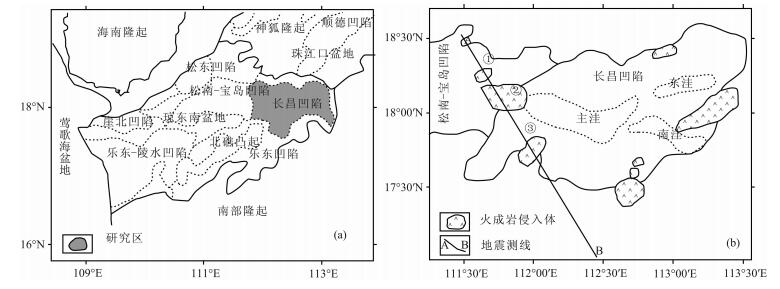
|
图 1 长昌凹陷构造单元划分(a)及地震测线位置图(b) Fig. 1 (a)Structural division of the Changchang Sag, (b)distribution of intrusions and location of the modelled seismic line |
本文拟基于最新的地震解释成果和相关热物性资料,通过有限元计算方法[22]评价了火成岩侵入体对区域温度场的影响,并进一步结合地层冷却史及Easy%Ro模型探讨其对烃源岩成熟度的影响.这一结果对评价侵入体对研究区内烃源岩生、排烃的影响,计算凹陷油气资源量等有重要意义.
2 计算方法与原理 2.1 热传导基本方程有限元法是求解热传导方程常用的数值方法之一,早已被运用于解决热传导问题[23],评价区域构造形态、高温岩浆侵入和地形变化等对区域温度场的影响[24-26].其本质上是将计算区域内的连续温度场离散成有限数量的温度点,然后求出给定条件下这些温度点上的温度值来近似代表需要求解的温度场.由于侵入体和围岩的热力学性质及地质的复杂性,我们假设侵入是瞬间的,散热方式主要是热传导,侵入体和围岩的热扩散率相同.其基本方程为:

|
(1) |
式中,T为温度(℃);t为时间(s);K为热导率(W/(m·K));Q为岩石的热产生值(μW/m3);μ为热容量,μ=ρc,ρ为密度(kg/m3),c为常压下的比热值(J/(kg·K)).
本文所讨论的边界条件为:1)上边界海底温度为10 ℃;2)下边界上的热流值为45 mW/m2(仅考虑侵入体的影响,屏蔽了形成侵入体时的高热背景)[27];3)左右边界假定为绝热边界(即没有热传递).
2.2 模型的建立模型的建立基于凹陷内一条穿越三个不同规模侵入体的地震测线,模拟剖面AB位置见图 1,长度为200km,高度为14km.侵入体(1)、(2)、(3)为锥状体,在沉积基底面上的半径分别为3km、6km、5km;高度分别为:9.2km、10km、3.7km.剖面特征见图 2.总体上具有琼东南盆地双层结构,上层表现为披盖式坳陷,下层则是断陷和断隆,具有典型的张性环境下断陷盆地的构造特征.根据地震反射特征及实际钻进层位标定可识别出T20、T30、T40、T50、T60、T70、T100反射界面,分别对应于乐东组、莺歌海组、黄流组、梅山组、三亚组、陵水组、崖城组、始新统的底部.研究区T60是破裂不整合面,代表了凹陷从断陷向坳陷转化的界面,界面之下发育了基底断裂和渐新统断裂体系,构造活动强,且断层控制沉积;界面之上断层基本不活动,一般认为是层序的“稳定”充填期[28].根据实测剖面情况,建立模型(模型形态见图 2右下角),并采用0.5km×0.5km网格,取时间步长为0.05 Ma对其进行二维有限元热模拟.
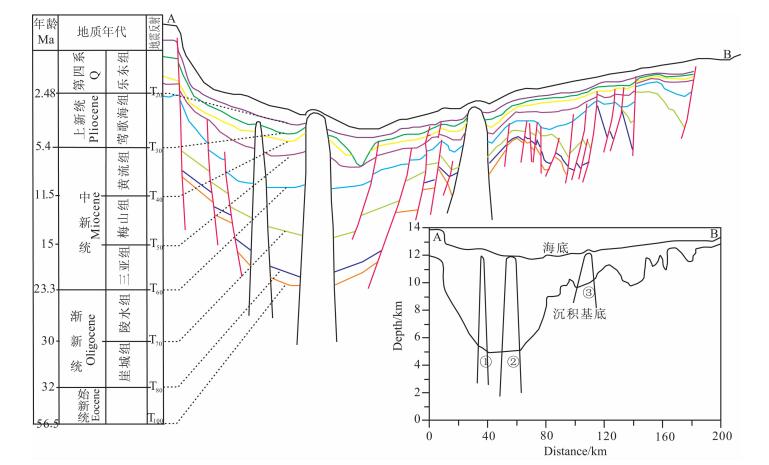
|
图 2 地震剖面及模拟模型简图 Fig. 2 Sketch showing the seismic profile and simulation model |
岩浆的温度随组分的不同而不同[29],目前,尚没有文献介绍琼东南盆地新生代火山活动的特点及岩性组成.根据珠江口盆地钻遇火山岩的情况来看,始新世早期以中酸性喷出岩和火山碎屑岩为主,中后期基性喷出岩逐渐增加,中新世以后,火山岩成分比较单一,全为玄武岩[30].邹和平等[31]认为中酸性火山岩是由于古近纪的火成岩组合来自大陆地壳之下的富集型地幔的熔融,岩浆中的深源成分逐渐增多,说明岩石圈在古近系发生了明显的减薄,软流圈地幔抬升较高,因此,新近系岩浆中的深源成分增多.据张健等[32]分析,南海北部不同盆地由于所处的地质构造环境差异,地幔热流不同,但总体上各坳陷地质成因机制及其形成、演化和衰亡过程基本相似,所以深部地热状况具有相似的特点.结合邹和平等[31]新近系岩浆中的深源成分增多的理论,推测琼东南盆地可能具有类似的岩性组成和变化特征,因此区内侵入体初始温度取980 ℃.其它模拟参数见表 1.
|
|
表 1 模拟参数 Table 1 Simulation parameters |
有机质演化过程中化学反应速率与温度呈指数关系,而与时间只呈线性关系,所以有机质的成熟度主要受温度的控制[35].本文侵入体对围岩温度的影响如图 3、图 4所示:侵入1 Ma后,侵入体温度迅速下降,温度界线开始消失(见图 3c),2 Ma后界线消失(见图 3d),5 Ma以后对围岩温度的影响微弱(图 3e),10 Ma以后侵入体与围岩温度完全一致(图 3f),与范桃园、张健的研究结论[1, 36]相符;侵入体不同深度冷却速率是不一样的,以侵入体(2)(规模最大)为例,侵入体中上部短时间内迅速冷却,侵入0.2 Ma后,侵入体中心的温度降至750 ℃,降幅超过200 ℃(图 4a),而侵入体底部温度在侵入0.2 Ma后下降温度小于100 ℃(图 4b).由此可知,随着深度的增加,侵入体对围岩温度的影响程度减小,但持续时间较长.

|
图 3 侵入体侵入后不同时刻的温度场剖面(a)侵入0.2 Ma后;(b)侵入0.5 Ma后;(c)侵入1 Ma后;(d)侵入2 Ma后;(e)侵入5 Ma后;(f)侵入10 Ma后. Fig. 3 Geothermal field along the modelled section for different times after intrusion(a)0.2 Ma, (b)0.5 Ma, (c)1 Ma, (d)2 Ma, (e)5 Ma, (f)10 Ma. |
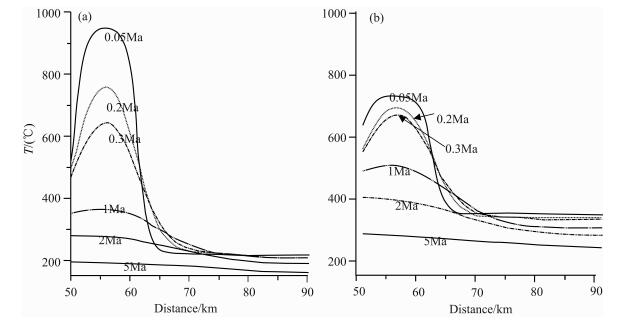
|
图 4 侵入体2侵入后温度随时间的变化(a)侵入体(2)中心(y约为7km);(b)侵入体(2)底部(y约为2km). Fig. 4 Temperature changing with time after intrusion for intrusion No.2(a)Intrusion center(at y ca.7km); (b)Bottom of intrusion 2(y ca.2km). |
针对不同的地质尺度,目前国内外应用于盆地热史的研究方法主要有两种:一是在岩石圈尺度上,根据盆地形成和演化的动力机制及地球内部热传播方式,建立相应的盆地数学模型,在已知或假定的初始和边界条件下,通过调整模型参数,使得模拟计算结果拟合实际观测的盆地构造沉降史而确定盆地底部热流史,进而结合盆地的埋藏史正演盆地的热史,称之为“构造-热演化法”.二是在盆地尺度上,利用盆地内的沉积地层中记载古地温信息的有机质、矿物、流体等(称作古温标或古地温计)来反演地层的热历史;据“古温计”直接反推出古地温范围,或据它们的热动力学机理,构造数学模型,定量反演地热史,称之为“古温标法”[37-38],这些方法用于热史重建各有优劣.由于研究区内目前为止还没有相应的“古温标”,所以热史反演行不通.而基于McKenzie[39]拉伸模型的构造热演化法只能计算得到基底热流史,不能反映后期侵入体的热流影响.
为了定量地评价火成岩侵入体对烃源岩成熟度的影响,我们分别选取了围绕三个侵入体2km、5km的特殊点,分析了侵入体对这些人工井热流史的影响.如图 5所示:规模最大的侵入体2对热流的影响最大,短时间内引起的热流异常可超过25mW/m2.个别人工井热流异常呈现双峰,可能是受到邻近侵入体的影响.但总体来说,侵入体对热流的影响与对围岩温度的影响一致,有显著影响的时限不超过1Ma.
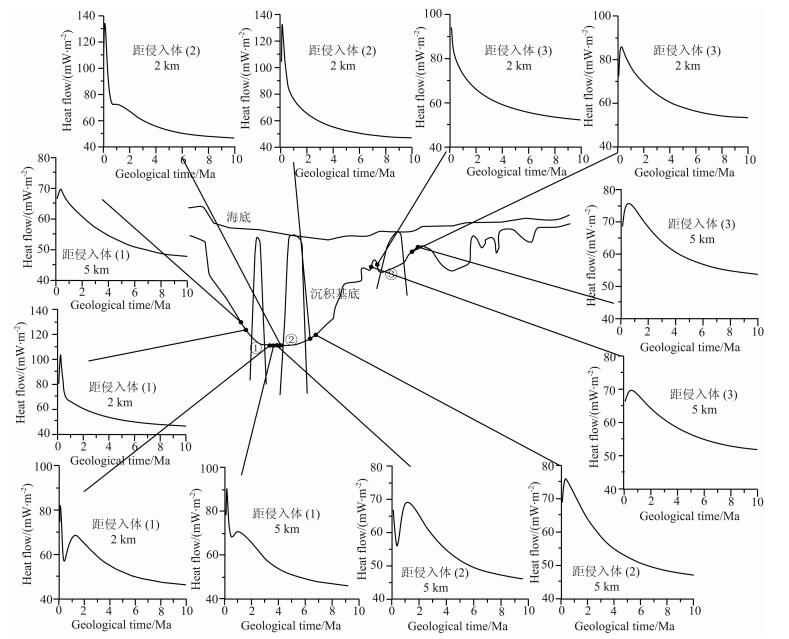
|
图 5 距侵入体2km、5km处人工井热史侵入体(1)与侵入体(2)之间的人工井热流异常呈现双峰,可能是两个侵入体之间的相互影响. Fig. 5 Thermal history of artificial wells 2 km and 5 km away from the three igneous intrusions Bimodal heat flow anomalies for artificial wells may be caused by interaction between two igneous intrusions. |
火成岩的异常热作用对烃源岩的影响主要表现在使镜质体反射率出现异常,使有机质成熟度增加,促使烃类的成熟、生成及排出.其影响程度与烃源岩距火成岩体的远近和火成岩体的规模有关[40-42].
本文以崖城组烃源岩为例,分析不同规模侵入体对距其不同距离处有机质成熟度的影响,基底热流来自基于过长昌凹陷地震测线的构造热演化计算结果[43],在此基础上,根据前述侵入体对热流的影响和持续时间,将其所产生的热作用折算成等效附加大地热流,定量分析侵入体对人工井烃源层有机质成熟度Ro的影响.图 6、7、8分别表示不同热史(考虑与不考虑侵入体对热流的影响)正演得到的距三个侵入体2km、5km处人工井崖城组烃源岩有机质成熟度史.可以明显地看出,当受热时间持续1 Ma时,侵入体1短时间内对距其2km处崖城组烃源岩成熟度Ro的影响可达到1.1%(见图 6a),对距其5km处烃源岩成熟度Ro的影响很小,约为0.15%(见图 6b);受热时间持续1 Ma时,侵入体2短时间内对距其2km处崖城组烃源岩成熟度Ro的影响可达到1.6%(见图 7a);对距其5km处烃源岩成熟度Ro的影响为0.4%(见图 7b);受热时间持续1 Ma时,侵入体3短时间内对距其2km处崖城组烃源岩成熟度Ro的影响为0.03%(见图 8a);对距其5km处烃源岩成熟度Ro几乎没有影响(见图 8b).总体说来,侵入体对烃源岩有机质成熟度的影响随侵入体规模、距侵入体的距离等因素不同而不同,侵入体3由于规模小,所以对人工井烃源岩有机质成熟度Ro的影响微弱.
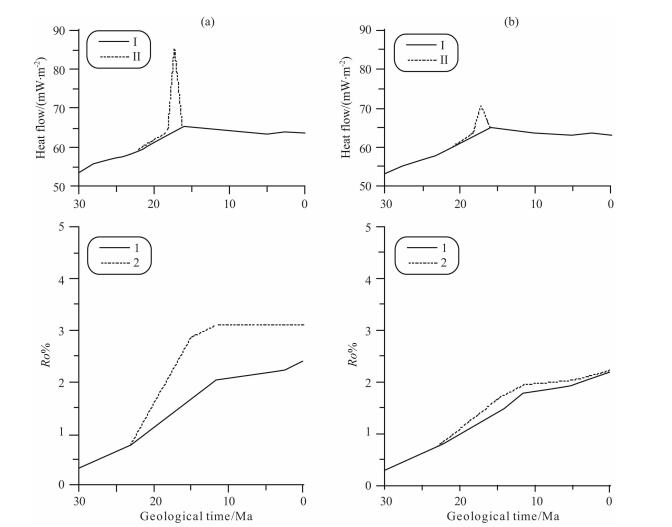
|
图 6 距侵入体(1)2km处(a)和距侵入体(1)5km处(b)人工井的热史及崖城组烃源岩有机质成熟度史Ⅰ-背景热史;Ⅱ-考虑火山影响的热史;1-崖城组烃源岩基于区域背景热史计算所得有机质成熟度史;2-崖城组烃源岩基于受侵入体(1)影响热史计算所得有机质成熟度史. Fig. 6 Thermal history and organic maturity for artificial wells(a)2 km away from igneous intrusion No.1 and (b) 5 km away from igneous intrusion No.1 Ⅰ-Background thermal history; Ⅱ-Thermal history for artificial well 2 km away from intrusion No.1;1-Organic maturity history of the Yacheng Formation based on the background thermal history; 2-Organic maturity history of the Yacheng Formation based on thermal history influenced by intrusion No.1. |
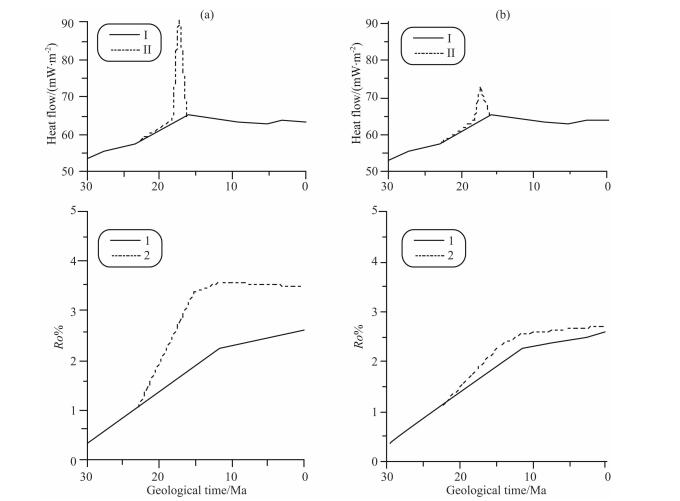
|
图 7 距侵入体(2)2km处(a)和距侵入体(2)5km处(b)人工井的热史及崖城组烃源岩有机质成熟度史Ⅰ-背景热史;Ⅱ-考虑火山影响的热史;1-崖城组烃源岩基于区域背景热史计算所得有机质成熟度史;2-崖城组烃源岩基于受侵入体(2)影响热史计算所得有机质成熟度史. Fig. 7 Thermal history and organic maturity for artificial wells(a)2 km away from igneous intrusion No.2 and(b)5 km away from igneous No.2 Ⅰ-Background thermal history; Ⅱ-Thermal history for artificial well 2 km away from intrusion No.2;1-Organic maturity history of the Yacheng Formation based on the background thermal history; 2-Organic maturity history of the Yacheng Formation based on thermal history influenced by intrusion No.2. |
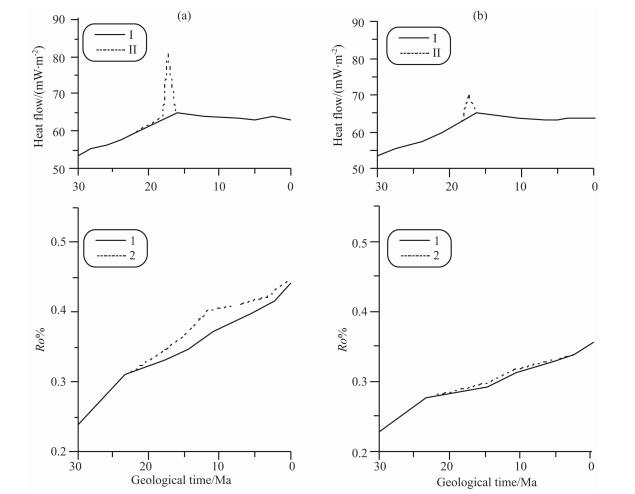
|
图 8 距侵入体(3)2km处(a)和距侵入体(3)5km处(b)人工井的热史及崖城组烃源岩有机质成熟度史Ⅰ-背景热史;Ⅱ-考虑火山影响的热史;1-崖城组烃源岩基于区域背景热史计算所得有机质成熟度史;2-崖城组烃源岩基于受侵入体(3)影响热史计算所得有机质成熟度史. Fig. 8 Thermal history and organic maturity for artificial wells(a)2 km away from igneous intrusion No.3 and(b)5 km away from igneous intrusion No.3 Ⅰ-Background thermal history; Ⅱ-Thermal history for artificial well 2 km away from intrusion No.2;1-Organic maturity history of the Yacheng Formation based on the background thermal history; 2-Organic maturity history of the Yacheng Formation based on thermal history influenced by intrusion No.3. |
关于岩浆侵入体对盆地热演化及生烃影响的论述很多,但大多数只是从定性的角度讨论,定量化较少[44-47].张健等[1]根据中国北方沉积盆地中岩浆侵入的一般特点,利用二维有限单元法计算了岩浆侵入体对沉积盆地温度结构的影响和对烃类成熟度的影响,得出几公里大小的侵入体热影响可以在时间上持续数百万年,在空间上扩散至十几公里.范桃园等[36]将该方法用于模拟美国某盆地尺度约为3~4km的分侵入体对盆地热演化的影响,得出的结论为在岩浆侵入以后,最初约0.4百万年内,岩浆周围一定范围(大约5km内)的岩石受到岩浆所释放热的显著影响.随着时间的演化,影响范围逐渐扩大,同时影响程度却逐渐降低.杨树春等[27]也用此方法分析了潮汕坳陷火成岩侵入体的影响,并认为研究区侵入体对烃源岩成熟度影响微弱.本文的模拟结果总体上符合前人的结论,只是根据研究区的情况不同,影响的时限、空间上有所不同.由于资料有限,本次模拟过程中,只考虑了岩浆的热传导过程,而未能考虑岩浆侵入过程中的热流体活动的影响[48-49].长昌凹陷的勘探开发还处于空白状态,区内实际钻井资料缺乏,随着今后实测烃源岩有机质成熟度Ro等资料的丰富,本次的模拟结果将会得到更进一步的证明与完善.
目前,几乎没有关于长昌凹陷侵入体的报道,本文根据最新的地震解释成果、热物性资料,利用二维有限元法计算了火成岩侵入体对凹陷区域温度场与热流史的影响,并进一步结合Easy%Ro模型探讨了侵入体热效应对烃源岩成熟度史的影响(以崖城组为例),得出以下几点认识:
(1)侵入后1 Ma以内,侵入体温度迅速下降;2 Ma以后,侵入体对温度场的影响微弱,5 Ma以后几乎没有影响,10 Ma以后,侵入体温度与围岩温度一致.侵入体对热流的影响与对温度的影响一致,有明显影响的时限不超过1 Ma,距侵入体2km处人工井的热流值增加5~25mW/m2.
(2)侵入体不同深度冷却速率不相同,随着深度的增加,侵入体对围岩温度的影响程度减小,但持续时间较长.
(3)研究区内侵入体对烃源岩有机质成熟度的影响随侵入体的规模、距侵入体的距离不同而不同.当受热时间持续1 Ma,侵入体1、2短时间内对距其2km处崖城组烃源岩成熟度Ro的影响明显,最高可使Ro值增加1.6 %,对距其5km处崖城组烃源岩成熟度Ro的影响为0.4%.而侵入体3由于规模较小,对烃源岩成熟度的影响微弱.
本文在评价侵入体对温度场、热演化、烃源岩有机质成熟度影响的时候,重点在于考虑单个火成岩侵入体的影响.如果区域内侵入体分布密集,某些位置可能会受到多个侵入体的共同影响(见图 5中热流双峰),在评价侵入体对整个区域的影响时则需根据具体的地质情况、侵入体的具体规模和位置等因素综合考虑.
致谢本文研究使用地震测线及解释成果由中海石油(中国)有限公司北京研究中心提供.
| [1] | 张健, 石耀霖. 沉积盆地岩浆侵入的热模拟. 地球物理学进展 , 1997, 12(3): 55–64. Zhang J, Shi Y L. The thermal modeling of magma intrustion in sedimentary basins. Progress in Geophysics (in Chinese) , 1997, 12(3): 55-64. |
| [2] | Zhu C Q, Xu M, Yuan Y S, et al. Palaeogeothermal response and record of the effusing of Emeishan basalts in the Sichuan basin. Chinese Science Bulletin , 2010, 55(10): 949-956. DOI:10.1007/s11434-009-0490-y |
| [3] | Sun Y G, Fu J M, Liu D H, et al. Effect of volcanism on maturation of sedimentary organic matter and its significance for hydrocarbon generation, a case:the East Sag of Liaohe Basin. Chinese Science Bulletin , 1995, 40(17): 1446-1450. |
| [4] | Wang D Y, Song Y C, Liu Y, et al. The influence of igneous intrusions on the peak temperatures of host rocks:Finite-time emplacement, evaporation, dehydration, and decarbonation. Computers & Geosciences , 2012, 38(1): 99-106. |
| [5] | Barker C E, Boney Y, Lewan M D. Fluid inclusion and vitrinite-reflectance geothermometry compared to heat-flow models of maximum paleotemperaure next to dikes, western onshore Gippsland Basin, Australia. International Journal of Coal Geology , 1998, 37(1-2): 73-111. DOI:10.1016/S0166-5162(98)00018-4 |
| [6] | Bishop A N, Abbott G D. Vitrinite reflectance and molecular geochemistry of Jurassic sediments-the influence of heating by Tertiary dykes (Northwest Scotland). Organic Geochemistry , 1995, 22(1): 165-177. DOI:10.1016/0146-6380(95)90015-2 |
| [7] | Fjeldskaar W, Helset H M, Johansen H, et al. Thermal modelling of magmatic intrusions in the Gjallar Ridge, Norwegian Sea:implications for vitrinite reflectance and hydrocarbon maturation. Basin Research , 2008, 20(1): 143-159. DOI:10.1111/bre.2008.20.issue-1 |
| [8] | Santos R V, Dantas E L, de Oliveira C G, et al. Geochemical and thermal effects of a basic sill on black shales and limestones of the Permian Irati Formation. Journal of South American Earth Sciences , 2009, 28(1): 14-24. DOI:10.1016/j.jsames.2008.12.002 |
| [9] | 王有孝, 范璞, 程学惠, 等. 异常地热对沉积有机质生烃过程的影响--以辉绿岩侵入体为例. 石油与天然气地质 , 1990, 11(1): 73–77. Wang Y X, Fan P, Cheng X H, et al. Influence of diabase intrusion on hydrocarbon generation of depositional organic matter. Oil & Gas Geolog (in Chinese) , 1990, 11(1): 73-77. |
| [10] | 朱传庆, 田云涛, 徐明, 等. 峨眉山超级地幔柱对四川盆地烃源岩演化的影响. 地球物理学报 , 2010, 53(1): 119–127. Zhu C Q, Tian Y T, Xu M, et al. The effect on thermal evolution of source rock in Sichuan basin by Emeishan supper mantle plume. Chinese Journal of Geophysics (in Chinese) , 2010, 53(1): 119-127. |
| [11] | Othman R, Arouri K R, Ward C R, et al. Oil generation by igneous intrusions in the northern Gunnedah Basin, Australia. Organic Geochemistry , 2001, 32(10): 1219-1232. DOI:10.1016/S0146-6380(01)00089-4 |
| [12] | 冯乔, 汤锡元. 岩浆活动对油气藏形成条件的影响. 地质科技情报 , 1997, 16(4): 59–65. Feng Q, Tang X Y. Magma activity's influence of conditions forming oil and gas pools. Geological Science and Technology Information (in Chinese) , 1997, 16(4): 59-65. |
| [13] | 万从礼, 金强. 东营凹陷纯西辉长岩对烃源岩异常生排烃作用研究. 长安大学学报(地球科学版) , 2003, 25(1): 20–25. Wan C L, Jin Q. Study on exceptional hydrocarbons generating and eliminating of gabbros to source rocks in Chunxi area of Dongying depression. Journal of Chang'an University (Earth Science Edition) (in Chinese) , 2003, 25(1): 20-25. |
| [14] | Chen R, He S, Wang Q. A preliminary discussion of magma activity on the maturation of organic matter:Taking Ggyucheng-Wenan area of Hebei Province as an example. Petroleun Expoloration and Development , 1989, 16(1): 29-38. |
| [15] | Galushkin Y I. Thermal effects of igneous intrusions on maturity of organic matter:A possible mechanism of intrusion. Organic Geochemistry , 1997, 26(11-12): 645-658. DOI:10.1016/S0146-6380(97)00030-2 |
| [16] | Robinson N, Parnell J, Brassell S. Hydrocarbon compositions of bitumens from mineralized Devonian lavas and carboniferous sedimentary-rocks, central Scotland. Marine and Petroleum Geology , 1989, 6(4): 316-323. DOI:10.1016/0264-8172(89)90028-7 |
| [17] | Finkelman R B, Bostick N H, Dulong F T, et al. Influence of an igneous intrusion on the inorganic geochemistry of a bituminous coal from Pitkin County, Colorado. International Journal of Coal Geology , 1998, 36(3-4): 223-241. DOI:10.1016/S0166-5162(98)00005-6 |
| [18] | Thorpe A N, Senftle F E, Finkelman R B, et al. Change in the magnetic properties of bituminous coal intruded by an igneous dike, Dutch Creek Mine, Pitkin County, Colorado. International Journal of Coal Geology , 1998, 36(3-4): 243-258. DOI:10.1016/S0166-5162(98)00006-8 |
| [19] | 陶维祥, 赵志刚, 何仕斌, 等. 南海北部深水西区石油地质特征及勘探前景. 地球学报 , 2005, 26(4): 359–364. Tao W X, Zhao Z G, He S B, et al. Petroleum geological conditions and exploration prospects in deepwater area of northwestern South China Sea. Acta Geosicientia Sinica (in Chinese) , 2005, 26(4): 359-364. |
| [20] | 龚再升, 李思田, 谢泰俊, 等. 南海北部大陆边缘盆地分析与油气聚集. 北京: 科学出版社, 1997 . Gong Z S, Li S T, Xie T J, et al. Dynamic Research of Oil and Gas Accumulation in Northern Marginal Basions of South China Sea (in Chinese). (in Chinese) Beijing: Science Press, 1997 . |
| [21] | 王振峰, 李绪深, 孙志鹏, 等. 琼东南盆地深水区油气成藏条件和勘探潜力. 中国海上油气 , 2011, 23(1): 7–13. Wang Z F, Li X S, Sun Z P, et al. Hydrocarbon accumulation conditions and exploration potential in the deep-water region, Qiongdongnan basin. China Offshore Oil and Gas (in Chinese) , 2011, 23(1): 7-13. |
| [22] | 张菊明, 熊亮萍. 有限单元法在地热研究中的应用. 北京: 科学出版社, 1986 . Zhang J M, Xiong L P. The Application of Finite Element Methods in Geothermal (in Chinese). (in Chinese) Beijing: Science Press, 1986 . |
| [23] | Bonneville A, Capolsini P. THERMIC:a 2-D finite-element tool to solve conductive and advective heat transfer problems in Earth Sciences. Computers & Geosciences , 1999, 25(10): 1137-1148. |
| [24] | 张菊明, 孙惠文, 熊亮萍. 区域地温场的数学模拟及实例剖析. 地质科学 , 1982(3): 315–321. Zhang J M, Sun H W, Xiong L P. Mathematical simulation of regional geothermal field and case analysis. Chinese Journal of Geology (in Chinese) , 1982(3): 315-321. |
| [25] | 魏东平, 周蕙兰. 渤海唐山地区的地下热结构及地表热流分布的数值模拟. 地震地质 , 1991, 13(3): 283–288. Wei D P, Zhou H L. Mathematical simulation of the thermal structure and heat flow distribution in the Bohai and Tangshan areas. Seismology and Geology (in Chinese) , 1991, 13(3): 283-288. |
| [26] | 田华, 张之立. 渤海及其邻区地壳热结构和热应力场的研究. 地震学报 , 1992, 14(1): 29–35. Tian H, Zhang Z L. Study on Bohai Sea and its adjacent crustal thermal structure and thermal stress field. Acta Seismologica Sinica (in Chinese) , 1992, 14(1): 29-35. |
| [27] | 杨树春, 仝志刚, 贺清, 等. 潮汕坳陷中生界生烃历史及火成岩侵入影响分析--以LF35-1-1井为例. 中国海上油气 , 2008, 20(3): 152–156. Yang S C, Tong Z G, He Q, et al. Mesozoic hydrocarbon generation history and igneous intrusion impacts in Chaoshan depression, South China sea:a case of LF35-1-1 well. China Offshore Oil and Gas (in Chinese) , 2008, 20(3): 152-156. |
| [28] | 吴时国, 孙启良, 吴拓宇, 等. 琼东南盆地深水区多边形断层的发现及其油气意义. 石油学报 , 2009, 30(1): 22–26. Wu S G, Sun Q L, Wu T Y, et al. Polygonal fault and oil-gas accumulation in deep-water area of Qiongdongnan Basin. Acta Petrolei Sinica (in Chinese) , 2009, 30(1): 22-26. |
| [29] | Touloukian Y S, Judd W R, Roy R F. Physical Properties of Rocks and Minerals. New York: McGraw-Hill, 1981 . |
| [30] | 陈长民, 施和生, 许仕策. 珠江口盆地(东部)第三系油气藏形成条件. 北京: 科学出版社, 2003 . Chen C M, Shi H S, Xu S C. Forming Condition of Tertiary Reservoirs in Pearl River Mouth Basin (East) (in Chinese). (in Chinese) Beijing: Science Press, 2003 . |
| [31] | 邹和平, 李平鲁, 饶春涛. 珠江口盆地新生代火山岩地球化学特征及其动力学意义. 地球化学 , 1995, 24(Suppl.): 33–45. Zhou H P, Li P L, Rao C T. Geochemistry of Cenozoic volcanic rocks in Zhu Jiangkou Basin and its geodynamics significance. Geochimica (in Chinese) , 1995, 24(Suppl.): 33-45. |
| [32] | 张健, 熊亮萍, 汪集旸. 南海深部地球动力学特征及其演化机制. 地球物理学报 , 2001, 44(5): 602–610. Zhang J, Xiong L P, Wang J Y. Characteristics and mechanism of geodynamic evolution of the South China Sea. Chinese Journal of Geophysics (in Chinese) , 2001, 44(5): 602-610. |
| [33] | 袁玉松. 南海北部陆缘深水区构造-热演化与烃源岩成熟度史研究. 北京: 中国科学院地质与地球物理研究所, 2007 . Yuan Y S. Tectonic-thermal evolution and source rock's organic maturity history of the deepwater area in the Northern Margin of the South China Sea (in Chinese). (in Chinese) Beijing: Institute of Geology and Geophysics, Chinese Academy of Sciences, 2007 . |
| [34] | Shi X B, Zhou D, Qiu X L, et al. Thermal and rheological structures of the Xisha Trough, South China Sea. Tectonophysics , 2002, 351(4): 285-300. DOI:10.1016/S0040-1951(02)00162-2 |
| [35] | Tissot B P, Pelet R, Ungerer P. Thermal history of sedimentary basins, maturation indexes, and kinetics of oil and gas generation. AAPG Bulletin , 1987, 71(12): 1445-1466. |
| [36] | 范桃园, 石耀霖, 周炎如. 沉积盆地热演化过程中的岩浆作用. 中国科学院研究生院学报 , 1999, 16(1): 63–69. Fan T Y, Shi Y L, Zhou Y R. Effect of magma intrusion on the thermal evolution in a sedimentary basin. Journal of Graduate School, Academia Sinica (in Chinese) , 1999, 16(1): 63-69. |
| [37] | 胡圣标, 汪集旸. 沉积盆地热体制研究的基本原理和进展. 地学前缘 , 1995, 2(4): 171–180. Hu S B, Wang J Y. Principles and progresses on thermal regime of sedimentary basins-an overview. Earth Science Frontiers (in Chinese) , 1995, 2(4): 171-180. |
| [38] | 何丽娟, 熊亮萍, 汪集旸, 等. 莺歌海盆地构造热演化模拟研究. 中国科学(D辑:地球科学) , 2000, 30(4): 415–419. He L J, Xiong L P, Wang J Y, et al. Tectono-thermal modeling of Yinggehai basin. Science in China (Series D) (in Chinese) , 2000, 30(4): 415-419. |
| [39] | McKenzie D. Some remarks on the development of sedimentary basins. Earth and Planetary Science Letters , 1978, 40(1): 25-32. DOI:10.1016/0012-821X(78)90071-7 |
| [40] | 陈荣书, 王青玲, 何生, 等. 岩浆活动对有机质成熟作用的影响初探--以冀中葛渔城-文安地区为例. 石油勘探与开发 , 1989, 16(1): 29–38. Chen R S, Wang Q L, He S, et al. Primary exploration of influence of the magmatic activity on organic maturation:Case study on the Geyucheng-Wen'an area of central Hebei. Petroleum Exploration and Development (in Chinese) , 1989, 16(1): 29-38. |
| [41] | 孙永革, 傅家谟, 刘德汉, 等. 火山活动对沉积有机质演化的影响及其油气地质意义--以辽河盆地东部凹陷为例. 科学通报 , 1995, 40(11): 1019–1022. Sun Y G, Fu J M, Liu D H, et al. Effect of volcanism on maturation of sedimentary organic matter and its significance for hydrocarbon generation, a case:The east sag of Liaohe Basin. Chinese Science Bulletin (in Chinese) , 1995, 40(11): 1019-1022. |
| [42] | Raymond A C, Murchison D G. Effect of volcanic activity on level of organic maturation in carboniferous rocks of east Fife. Midland Valley of Scotland Fuel , 1988, 67(8): 1164-1166. |
| [43] | 单竞男. 南海北部深水区热体制及烃源岩成熟度史研究. 北京: 中国科学院地质与地球物理研究所, 2011 . Shan J N. Thermal regime and source rock maturation history in deepwater area, the Northern Margin of the South China Sea (in Chinese). (in Chinese) Beijing: Institute of Geology and Geophysics, Chinese Academy of Sciences, 2011 . |
| [44] | Jaeger J C. The temperature in the neighborhood of a cooling intrusive sheet. American Journal of Science , 1957, 255(4): 306-318. DOI:10.2475/ajs.255.4.306 |
| [45] | Simoneit B R T, Brenner S, Peters K E, et al. Thermal alteration of Cretaceous black shale by basaltic intrusions in the Eastern Atlantic. Nature , 1978, 273(5663): 501-504. DOI:10.1038/273501a0 |
| [46] | Mongelli F, Zito G, de Lorenzo S. Thermal effects of long intrusions. Geothermics , 2000, 29(3): 347-365. DOI:10.1016/S0375-6505(00)00003-1 |
| [47] | Jaeger J C. Thermal effects of intrusions. Reviews of Geophysics , 1964, 2(3): 443-466. DOI:10.1029/RG002i003p00443 |
| [48] | 张健, 石耀霖. 热泉地区岩浆侵入的热演化特征. 中国科学院研究生院学报 , 1998, 15(2): 171–176. Zhang J, Shi Y L. The characteristic of thermal evolution of magma intrusion in hot spring area. Journal of Graduate School, Academia Sinica (in Chinese) , 1998, 15(2): 171-176. |
| [49] | 石耀霖, 王其允. 沉积载荷致密排水对沉积盆地温度结构和成油窗口的影响. 石油学报 , 1992, 13(3): 19–26. Shi Y L, Wang Q Y. Geotherms and oil generation window in sedimentary basins thermal effects of compaction and discharge. Acta Petrolei Sinica (in Chinese) , 1992, 13(3): 19-26. |
 2013, Vol. 56
2013, Vol. 56

